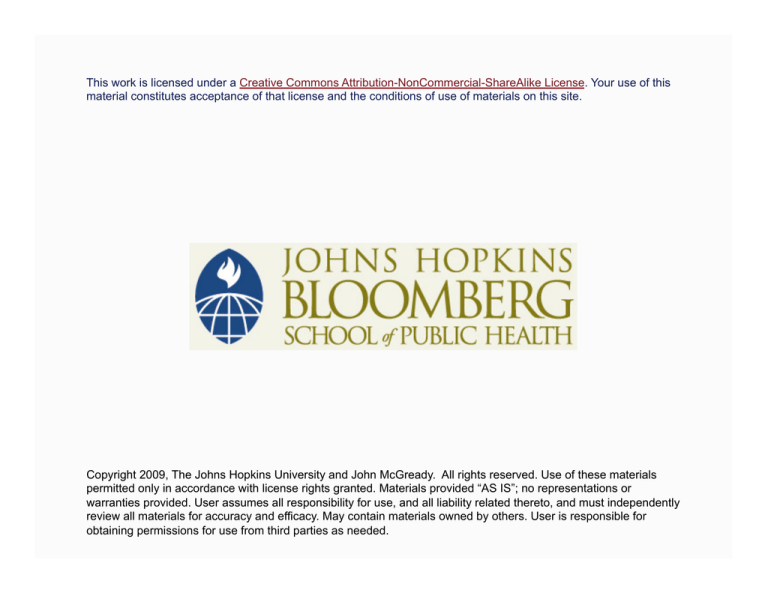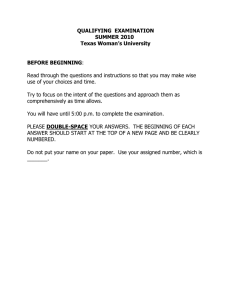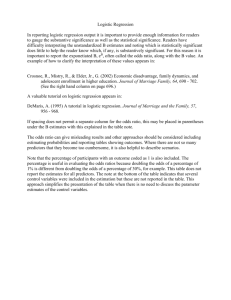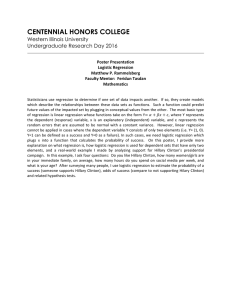
This work is licensed under a Creative Commons Attribution-NonCommercial-ShareAlike License. Your use of this
material constitutes acceptance of that license and the conditions of use of materials on this site.
Copyright 2009, The Johns Hopkins University and John McGready. All rights reserved. Use of these materials
permitted only in accordance with license rights granted. Materials provided “AS IS”; no representations or
warranties provided. User assumes all responsibility for use, and all liability related thereto, and must independently
review all materials for accuracy and efficacy. May contain materials owned by others. User is responsible for
obtaining permissions for use from third parties as needed.
Multiple Logistic Regression
John McGready
Johns Hopkins University
Section A
Multiple Logistic Regression
Multiple Logistic Regression
In the previous sections of this lecture, we observed a
positive association between CHD and positive
association between CHD and smoking
Continued
4
Multiple Logistic Regression
What if smoking is also associated with age?
Age could be a confounder of the smoking-CHD
relationship (and vice-versa)
Continued
5
Multiple Logistic Regression
Can we estimate the age adjusted relationship between
CHD and smoking?
Continued
6
Multiple Logistic Regression
Multiple logistic regression allows us to have more than
one predictor in our model
We can also estimate the association between each
predictor and Pr(y = 1) controlling for all other predictors
Continued
7
Multiple Logistic Regression
Here, we need a logistic regression model with two
predictors:
p = Pr(CHD),
= age,
= smoke
Continued
8
Multiple Logistic Regression
How would we interpret the coefficients from a multiple
logistic regression? And the resulting odds ratio
estimated?
p = Pr(CHD),
= age,
= smoke
Continued
9
Multiple Logistic Regression
is the age variable
is the estimated regression coefficient associated with
age
estimates the log(OR) for comparing two individuals
(groups) who differ by one year in age and are either
both smokers or non-smokers
Continued
10
Multiple Logistic Regression
Write out two equations
Obs 1: smoker, k years-old
Obs 2: smoker, k+1 years-old
Continued
11
Multiple Logistic Regression
Write out two equations
log(odds 2) =
log(odds 1) =
Continued
12
Multiple Logistic Regression
Simplify
log(odds 2) =
log(odds 1) =
Continued
13
Multiple Logistic Regression
Subtract
log(odds 2) =
log(odds 1) =
Continued
14
Multiple Logistic Regression
Subtract
log(odds 2) =
log(odds 1) =
Continued
15
Multiple Logistic Regression
So, = log(odds of CHD for Obs #2) – log(odds of CHD
for Obs #1)
By property of logs:
= log
Continued
16
Multiple Logistic Regression
is the age variable
is the estimated adjusted OR of CHD associated with
age, after adjusting for smoking status
This
compares two individuals (groups) of the
same smoking status where one individual (group)
is one year older than the comparison group
Continued
17
Multiple Logistic Regression
is the smoking variable
is the estimated regression coefficient associated with
smoking
estimates the log(OR) for comparing two individuals
(groups) of the same age, where one is a smoker and the
other is a non-smoker
Continued
18
Multiple Logistic Regression
is the smoking variable
is the estimated adjusted OR of CHD associated with
smoking, after adjusting for age
This
compares two individuals (groups) of the
same age where one individual (group) is a smoker
and the other is a non-smoker (reference)
19
Inference in Multiple Logistic Regression
We can calculate CIs and p-values for each coefficient
and hence for each adjusted OR
Each coefficient estimate has its own associated standard
error
20
Inference in Multiple Logistic Regression
Stata results
21
P-Value for Age
P-value for testing:
S
S
Answering question:
After adjusting for smoking status, is there a CHD/
age relationship in population?
22
Let’s Go to Stata
Continued
23
Let’s Go to Stata
Continued
24
Let’s Go to Stata
25
P-Value for Smoking
P-value for testing:
S
S
Answering question:
After adjusting for age, is there a CHD/smoking
relationship in population?
26
Let’s Go to Stata
Continued
27
Let’s Go to Stata
28
Interpretation
In a sample of 58 individuals, a multiple logistic
regression was performed to estimate the relationship
between CHD evidence and an individuals’ age and
smoking status
Both age (p < .001) and smoking (p = .005) were found to
be significant predictors of CHD
Continued
29
Interpretation
The adjusted OR associated with a one year increase in
age was 1.17 (95% CI 1.08 to 1.27)
The adjusted OR associated with smoking was 11.0 (95%
CI 2.0–59.2)
30
Age a Confounder
The adjusted OR associated with smoking was 11.0
When we estimated the OR between CHD and smoking,
without adjusting for age, our estimate was 4.7
31
In General
Coefficients, from a multiple logistic regression, estimate
the magnitude of each predictor/outcome relationship
after adjusting for all other predictors in the model
The estimates can be exponentiated to get associated
adjusted odds ratios
32





